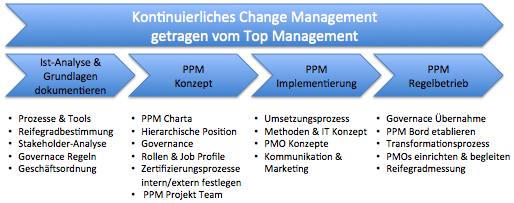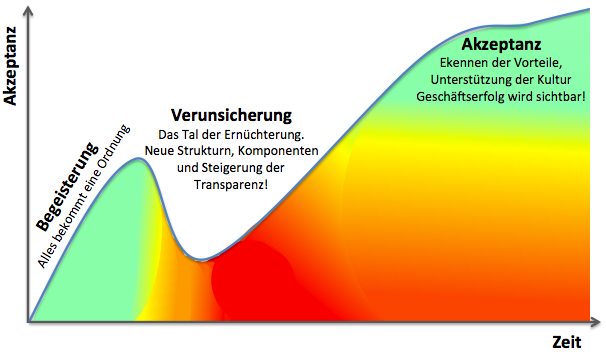
What does the introduction of a PMP (Project Management Program) mean and what should be considered?
First of all, don’t shoot sparrows with cannons! Anyone who wants to set up a PMP in a small company with a small number of projects is 100% wrong. But if a company with hundreds of projects in different organizational units, with foreign subsidiaries and increasing sales driven by the project business wants to do without a PMP, it most probably reduces its achievable margins. For all other cases, the establishment of a single project management office is sufficient.
If you want to introduce a PMP, then you are also launching a new project. The methodology is the same as for setting up a project:
First you create an analysis of the actual situation.
From this you then derive a tailor-made concept tailored to your specific case.
Finally, you implement this concept, measure the progress of the degree of implementation and transfer it to regular operation.
You bring all relevant stakeholders on board across all phases through smart change management. This ensures acceptance within the company and the success of the PMP.
A PMP must be individually adapted to the current framework conditions and the project management maturity level of the company.
When setting up a PMP, the challenge is to design it to fit your organization. The current framework conditions as well as the project management maturity of the company have to be taken into account.
Orientation provides a generic framework for the structure of the PMP, since there is no standard procedure model.
Before you actively start the first phase to set up the PMP, it must be clarified whether the quotation sales phase must be included in the consideration, or whether only the processing phase, with or without service phase, should be included.
Introduction of a PMP divided into four phases including change management

The introduction of a PMP is divided into four phases including change management.
Phase Ist-Analyse
The first step in introducing a PMP is an as-is analysis. The governance rules, PM methods, processes and at least tools used so far as well as the most important ongoing projects are critically examined for weak points.
At the beginning, it must be checked what should be treated as project business at all and thus fall under the responsibility of the PMP. It is very important to differentiate between the project business and the system business, which is often difficult to distinguish. Here, if available, the rules of procedure of the individual areas can provide clarity. Especially when it comes to which responsibilities and tasks need to remain in the operational organizational units.

The company-specific project business type analysis provides the necessary basis for decision-making.
Project transaction types analysis, decision support for a PMP or only PMOs
In the initial analysis, the following main criteria shall be fully covered:
- Governace regulations
- the rules of procedure, including those of the organizational units
- types of business
- Processes and core processes
- IT Map
- ERP systems
Weitere Kriterien sind:
- A current and complete and thus meaningful prioritized project list selected according to organizational units.
- Analysis of the project business Control environment Reporting according to hierarchy levels.
- Already now processes can be critically questioned on first Wast aspects.
Existing processes in the organization’s project management must be critically scrutinized. And you urgently need to analyze the effectiveness and efficiency of the tools and methods used.
The organizational form (line / matrix) and also the PM training or career area are of importance.
With the help of these findings you can determine an individual maturity level of the project management in the company. You must document this, because it forms the basis for the measurability of the benefits of a PMP for PMOs as well. This is the only way to clearly present the improvements achieved later.
Since the establishment of a PMP, but also of a PMO, is usually a politically sensitive issue because the PM process works across departmental boundaries, you will urgently need reports on positive changes, especially in the initial phases.
Based on this, you will determine the actual goals of the PMP. Stakeholder analysis is the best way to do this: Who are the interest groups of the new PMP and what strategic decisions should be derived from the analysis and what benefits do they seek?
The group of stakeholders extends from the management levels and executives to project managers, controllers and employees. Everyone expects a value contribution that must be identified in advance.
Watch out!
This is where a heavy drop of wormwood comes into play, often considered far too late! All stakeholders expect a significant increase in efficiency and, associated with this, an improvement in the company’s results. But as I know, a significant increase in efficiency also means an increase in transparency! And this is where the tension begins that can jeopardize your entire project step by step. Because an increase in transparency at the same time means the loss of loved leeway, its often perceived as brutal disclosure and the loss of personally developed unique selling propositions. And there are a maximum of persuasion up to a culture change in the enterprise is necessary.
Only with experience can you sufficiently capture and evaluate this aspect of the corporate culture in the actual analysis. A neutral person would be best suited to accompany the implementation.
Always keep in mind that the PMP is a service provider whose success depends on how satisfied the stakeholders are as “customers”. To do this, you must involve them at an early stage in order to be able to define the right goals.
Tip:
As far as possible, make the results obtained available for inspection on a generally accessible platform (of course in consultation with top management). Because, if a possibly necessary accompanying cultural change is to be successful, the transparency of your work must be reflected back into the company.
After the analysis of the actual state and the formulation of the expectations, the gap analysis follows. This shows the gap analysis between the current and desired status of project management in the company. It can be defined with a PM maturity model to be introduced step by step.
From this you derive recommendations for action, which should also include immediate measures in the form of quick wins. You should implement these quick wins as early as possible so that the PMP can steadily increase its acceptance with quick initial successes.
Our recommendation: Your first Quick Win could be a prioritized project list filterable by organizational units and regions, in a first simple version with only a few columns. This gives you an initial overview of the project landscape. This gives all stakeholders a quick overview of what projects are currently running, where and to what extent.
Let’s be honest: do you have a complete project list?
Most BW/BI systems of the ERP landscape offer fast evaluations here.
To have this list in your hands after just a few weeks would certainly be a great advantage for everyone involved.
Conception phase, defines task areas and resource requirements
The defined tasks must now be prioritised and the organisational form as well as the hierarchical position and competences of the PMP defined. The PMP must be clear about its mandate and services. This is best recorded in a charter to the PMP, which is signed by top management and published in the company.
- Should it work as a pure service unit and, for example, provide tools for the project business.
- Is there an authority to issue instructions or only a recommendation?
- Is his task to train project managers to certify internally/externally and to coach as well as to ensure the quality of projects?
- What are the expectations regarding project management excellence?
- To what extent should new methods such as Scrum, Lean, Agile gain a foothold in the project business?
The tasks of a PMP are often varied and the expectations of its stakeholders very high (see again “Watch out!“). For this reason, a focus on the most obvious fields of activity should be placed at the start of the project.
Here again a first selection for the PMP for the start:
- Das Strategische PMP (SPMP) kümmert sich um das Aufsetzen und Durchführen von Projekten. Es wählt Projekte aus und priorisiert sie. Zudem erstellt das PMP Nutzwertanalysen und legt die Rahmenbedingungen für das Projektmanagement fest.
- If the focus of the new PMP is on training and coaching, it will focus on personnel development measures for project managers and project teams.
- In Project Services, operational support is the main work. For example, the PMP moderates workshops or temporarily takes over the work of a project controller.
- If methods and processes form the core competence of the PMP, it primarily defines them and also provides suitable IT tools.
Project portfolio controlling monitors project progress and defines control measures. The focus here is on supporting adaptation to the agile digital world with trend reports. Here, the PMP collects project information and prepares it for decision-making bodies. - The Strategic PMP (SPMP) is responsible for setting up and implementing projects. It selects and prioritizes projects. In addition, the PMP prepares benefit analyses and defines the framework conditions for project management.
Core areas for a PMP

Tasks of the PMO or strategic PMO
For a start, it is recommended to start with one or two of these task fields. This way you do not overload your organization. In addition, the PMP mission should be officially communicated to the workforce by top management.
Stakeholders often tend to overload a PMP with tasks. By means of a practical and individual mandate declaration, which is coordinated with all stakeholders, you achieve a realistic task of the PMP.
PMOs cannot and should not please everyone. There is a fixed charter signed by top management.
A newly introduced PMP is virtually a foreign body in the company. As a rule a long way (at least 3 years) is to be gone up to the matter of course. Therefore it is necessary to protect this path against changes in the top management.
This is important:
Make sure that everyone knows about the existence of the new PMO and what it is responsible for. In this way, expectations can be clarified and the services offered can be advertised so that they are actually requested and used.
Based on the PMP range of services, the next step is to derive the resource requirements.
The qualification and motivation of the PMP employees is of great importance. On the one hand, the personnel must have a certain service mentality, but on the other hand they must also be able to say governance characteristics and “no” and check compliance with the established rules in a suitable form.
The PMP management must be staffed by a senior employee. This person should have organizational skills as well as many years of experience in project management and ERP. A high level of social competence is also important.
Phase Implementation
During implementation, you will gradually implement all PM processes and methods defined in the conception phase. You will also ensure the necessary IT infrastructure.
Now is the time to train the PMP staff and prepare them for their future tasks in a Start UP workshop.
If change management was previously practiced during the different phases, it will now become even more important. One of the most important tasks of the PMP is to practice smart self-marketing. Only those who clearly emphasize their benefits will be able to gain acceptance within the company.
Ensure clear communication of the PMP’s areas of responsibility.
For change communication, a PMP homepage in the company’s own intranet is ideal. This should contain information about the organization and services of the PMP, process flows in the project management of the company as well as the PMP team. And as already mentioned, if you want to increase transparency, you must also communicate your measures and successes to the workforce in a transparent and comprehensible manner.
Phase PMP introduction and control operation
After implementation, the PMP is transferred to regular operation. If the PMP was initiated with the cooperation of an external consulting firm, it is now time to transfer the entire responsibility to internal employees.
It is always an individual decision to what extent the external consultants will accompany the PMP on certain issues. Depending on the progress of the qualification measures, you may also want to consider coaching the internal project managers or the PMP.
Important! Focus on change management right from the start.
Throughout all phases, from the as-is analysis to the transition to regular operation, change management runs parallel to all work. You initiate a cultural change right from the start and the newly introduced PMP must convince all stakeholders of the benefits as quickly as possible in order to increase acceptance.
There are three main sections here:
Section 1:
If the PMP succeeds in producing quick wins early on, stakeholders will initially be pleased that someone will finally take care of the issues to be dealt with. They are then open to the PMP.
Section 2:
This is usually followed by a phase of disillusionment as soon as new structures and competencies are introduced. Here, no quick wins are achieved at first, and with increasing transparency, colleagues begin to become sceptical. They are now beginning to question what impact the new PMO and its objectives will have on them and to what extent it could possibly harm them.
Section 3: If the introduction is successful, the benefits of the PMP will ultimately be recognized. The initial scepticism gives way to constructive cooperation. Now the PMP can gradually introduce a new project management culture into the company and fill it with life.
Acceptance process for the introduction of PMP

Success stands and falls with the backing of top management and their willingness to Transform the company.
Provide for a promoter of your PMP who also asserts unpleasant things in critical situations. You need someone to represent your foreign policy. Your PMP can only be established permanently if:
- you have the backing of top management,
- the tasks in the PMP Charter are clearly defined,
- the competences of the PMP are communicated within the company.
The corporate culture also plays an important role in the success of the new PMO.
This means:
The PMO’s task is to ensure transparency in the project landscape. The success of a PMO can also be measured by how much transparency is desired in the company and is actually lived by all participants.
PMP in Transition: Where is the Trend Going?
In conclusion, the PMP is a hub for various interest groups. More and more is expected of it.
A PMP today is expected to develop in the direction of business excellence. That means it must always try to become better than the best by imitating bankmarks within the industry. With the Industry 4.0 Standard, it is already becoming apparent today that it is a matter of identifying the Key Performance Indicators, which makes it possible to establish scorecards with which management can be averted or mitigated before potential profit-reducing events, i.e. looking ahead, occur.
Active participation in the alignment and prioritization of the project portfolio is also becoming increasingly important, as company boundaries are becoming increasingly permeable in the digital market. This will also mean that the aspects relating to the protection of one’s own data will become more and more important.
It is increasingly important to do the right things before focusing on doing the right things.
The success factors for introducing a PMP:
1. honest and thorough analysis of PM vulnerabilities
2. complete stakeholder analysis
3. clear differentiation between PMP responsibility and tasks of the operational units
4. maturity level determination for progress documentation
5. to realize Quick Wins as early as possible
6. clearly define PMP task areas, coordinated with the stakeholders
7. prioritize task fields for startup and start with focus on Quick Wins
8. comprehensive communication of the PMP order by top management
9. focus on change management and transparency right from the start
10. top management fully supports the transformation process
In summary, a PMP means successfully introducing
Start the PMP as an internal company project. After the initiation comes the conception, implementation and then the regular operation, i.e. at this point at the latest it is a component of the company organisation with a clear corporate mission. Accompanying the right approach, further factors determine success and failure:
- clever change management,
- the backing of the top management and
- the absolute will for more transparency in the company.
Because even the best PMP can only work successfully if stakeholders recognize the added value of the new organizational unit and actively participate. Then you have the acceptance you need for success.
